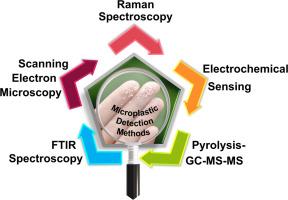Emerging analytical frontiers in microplastic detection: From spectroscopy to smart sensor technologies
IF 3.7
Q1 CHEMISTRY, ANALYTICAL
引用次数: 0
Abstract
Microplastics (MPs) and nanoplastics (NPs), defined as synthetic polymeric particles smaller than 5 mm and 1 μm, respectively, have emerged as pervasive and persistent pollutants across aquatic, terrestrial, and atmospheric environments, as well as within biological systems. Their heterogeneous physicochemical nature spanning diverse polymer compositions, morphologies, and surface chemistries complicates detection, especially in complex matrices at environmentally relevant concentrations. This review critically examines the recent advances in analytical methodologies for the detection, identification, and quantification of MPs and NPs, with a focus on interdisciplinary innovations spanning vibrational spectroscopy (µ-FTIR, µ-Raman, SRS), thermal decomposition-mass spectrometry (Py-GC–MS, TED-GC–MS, TOF-SIMS), and emerging electrochemical sensing strategies (EIS, PEC, and voltammetric sensors). Particular attention is given to electrochemical platforms that exploit polymer–electrode interfacial interactions, enabling label-free, sensitive, and real-time detection with potential for miniaturization and in-field deployment. Additionally, the integration of artificial intelligence and machine learning algorithms with high-dimensional spectral and electrochemical datasets is discussed as a transformative approach for enhancing classification accuracy, reducing analysis time, and facilitating automated detection. The review also highlights recent demonstrations of point-of-care devices, smartphone-integrated sensors, and microfluidic-based capture systems capable of detecting MPs/NPs in environmental and biological matrices. Finally, key challenges, including nanoplastic traceability, spectral overlap, lack of standardization, and the absence of certified reference materials, are evaluated, and future directions are proposed for the development of unified, high-throughput, and regulatory-compliant detection frameworks.

微塑料检测的新兴分析前沿:从光谱学到智能传感器技术
微塑料(MPs)和纳米塑料(NPs)分别被定义为小于5毫米和1 μm的合成聚合物颗粒,它们已成为水生、陆地和大气环境以及生物系统中普遍存在的持久性污染物。它们的异构物理化学性质跨越了不同的聚合物组成、形态和表面化学,使检测变得复杂,特别是在与环境相关的浓度的复杂基质中。本文综述了MPs和NPs检测、鉴定和定量分析方法的最新进展,重点关注跨学科创新,包括振动光谱(微傅里叶红外光谱、微拉曼光谱、SRS)、热分解质谱(Py-GC-MS、TED-GC-MS、TOF-SIMS)和新兴的电化学传感策略(EIS、PEC和伏安传感器)。特别关注利用聚合物-电极界面相互作用的电化学平台,实现无标签、敏感和实时检测,具有小型化和现场部署的潜力。此外,本文还讨论了人工智能和机器学习算法与高维光谱和电化学数据集的集成,作为提高分类精度、减少分析时间和促进自动化检测的变革性方法。该综述还强调了最近的现场护理设备、智能手机集成传感器和基于微流体的捕获系统的演示,这些系统能够检测环境和生物基质中的MPs/NPs。最后,对纳米塑料可追溯性、光谱重叠、缺乏标准化和缺乏认证标准物质等关键挑战进行了评估,并提出了统一、高通量和符合法规的检测框架的未来发展方向。
本文章由计算机程序翻译,如有差异,请以英文原文为准。
求助全文
约1分钟内获得全文
求助全文

 求助内容:
求助内容: 应助结果提醒方式:
应助结果提醒方式:


